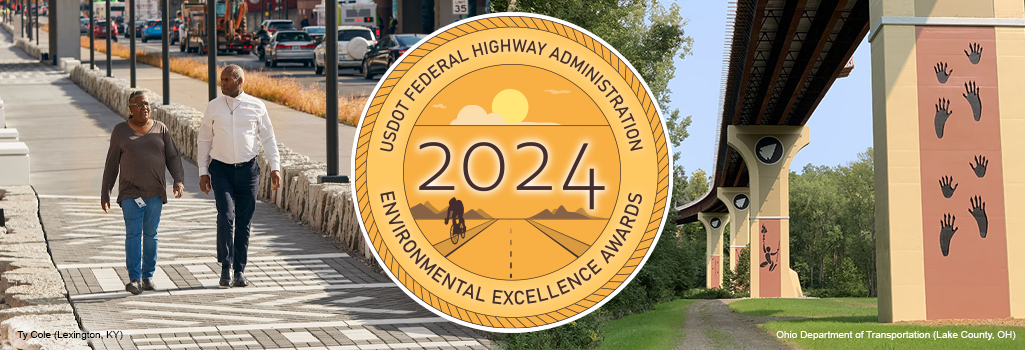| |
Accelerating Project Delivery
- Deploys approaches to accelerate project delivery and demonstrates time savings and/or improved environmental outcomes.
- Applications may also consider: accelerated processes; use of virtual or proactive public involvement; strategic partnerships and/or collaboration; Planning and Environment Linkages, Every Day Counts, Eco-logical, or other FHWA national initiatives; programmatic agreements; safety and the Safe System approach; innovative mitigation measures, such as capping; alternative uses of Right-of-Way; and/or noise abatement from transportation projects, including incorporating innovative designs and materials for noise barriers.
|
Active and Multimodal Transportation
- Improves multimodal networks, including partnerships to finance, develop, and/or implement multimodal infrastructure projects.
- Applications may also consider: mobility; mode shift; connectivity; accessibility; safety; Safe System approach; convenience for all users; complete streets; micromobility; e-bikes; pedestrians and bicycles; shared mobility; transit systems; economic benefit; and/or equal opportunities.
|
Air Quality and Greenhouse Gas Emissions
- Demonstrates creative solutions, such as clean energy or renewable energy, to lead to quantifiable reduction in and/or improved tracking of air pollutants and/or greenhouse gas emissions.
- Applications may also consider: project level transportation conformity analyses; alternative uses of Right-of-Way; climate change; environmental justice; clean energy; and/or renewable energy.
|
Climate Change Adaptation, Resilience, and Sustainability
- Ensure transportation plays a central role in tackling climate change impacts. Promotes resilient and sustainable transportation systems that benefit and protect communities through approaches that promote adaptation to and mitigate risks from climate change impacts.
- Applications may also consider: modern, sustainable, and resilient infrastructure; program level sustainability initiatives; sustainable materials; environmental justice; resilience solutions that incorporate community needs; equity; and/or assisting underserved communities.
|
Collaboration and Partnership
- Demonstrates a commitment to interagency partnerships by establishing meaningful consultation and collaboration among three or more agencies from a range of sectors (public, private, non-profit) to ultimately enhance the human and/or natural environment, or incorporate those considerations into their organization.
- Applications may also consider: improved environmental- or community-friendly outcomes; inclusive solutions; collaborative thinking; interagency partnerships to foster proactive public involvement; technical assistance for non-traditional discretionary grant applicants; the climate crisis and risk mitigation; resilience solutions that incorporate community needs; safety; systemic barriers to equity; environmental justice; and/or stakeholder engagement.
|
Community Considerations in Transportation Improvements
- Demonstrates how an increased amount or range of public involvement efforts met community needs and led to positive economic development outcomes.
- Applications may also consider: State and community health; equity; thriving communities; complete streets; safety; economic benefit; virtual public involvement; engaging underserved populations; expanding affordable access to transportation jobs and business opportunities; and/or addressing systemic barriers to equity, environmental justice, and/or opportunity.
|
Complete Streets and Context Sensitive Solutions
- Develops exemplary complete streets policies, plans and/or projects supporting equitable streets and networks that prioritize equity, safety, comfort, and connectivity to destinations for all people who use the on-street and off-street network. This can include context sensitive transportation plans, policies and projects that preserve and enhance community and natural environments.
- Applications may also consider: public transportation users; non-drivers; children; older individuals; individuals with disabilities; motorists; pedestrians; bicyclists; e-scooters; delivery vehicles; freight vehicles; convenience for all users; sustainability throughout the transportation network; stakeholder engagement; novel technology uses; innovation; curbside management; and/or hubs that integrate mobility and land use.
|
Cultural and Historical Resources
- Demonstrates how investments in cultural and historic resource preservation and/or Tribal consultation during planning and early project development contributed to improved environmental outcomes.
- Applications may also consider: meaningful stakeholder engagement; equity considerations integrated into planning; consultation and collaboration with American Indian and Alaska Native Tribal Nations; and/or recognition or consideration of historic, cultural, and/or community values.
|
Ecosystems, Habitat, and Wildlife
- Enhances, restores, preserves and/or mitigates impacts to ecosystems or habitats through strategic partnerships with resource agencies.
- Applications may also consider: ecosystem integrity; monitoring; adaptive management and/or improved environmental outcomes.
|
Educational and Training Programs
- Develops educational or training programs that improve the public understanding of the transportation decision-making process or delivers skilled and prepared transportation workers with environmental expertise.
- Applications may also consider: enhanced understanding of the interactions between the human and natural environments, climate change, equity, and/or environmental justice; public engagement; safety; expanding affordable access to transportation jobs; and/or workforce development.
|
Environmental Research
- Showcases applied research that advances technology, contributes to knowledge, and/or provides practical solutions for transportation-related issues while considering environmental and community impacts.
- Applications may also consider: scalable and applied research; equity; economic benefit; innovation; environmental justice; sustainable infrastructure; designing flexibility into transportation systems; climate resilience; renewable energy; safety; human and/or natural environment improvements; and/or the transportation decision-making process.
|
Equity and Environmental Justice
- Demonstrates improvements in equity, community connections, and/or quality of life impacts on environmental justice populations or other underserved groups. Supports and engages people and communities to promote safe, affordable, accessible, and multimodal access to opportunities and services while reducing transportation-related disparities, adverse community impacts, and health effects.
- Applications may also consider: indirect and cumulative effects; meaningful public involvement efforts; representative public participation; quantitative Equity Screening; equity in planning; complete streets; community stakeholder engagement; safety; environmental justice; resilience solutions that incorporate community needs; and/or assisting underserved communities.
|
Roadside Resource Management and Maintenance
- Promotes roadside management and maintenance methods that contribute to high quality, sustainable environments.
- Applications may also consider: integrated management; alternative uses of Right-of-Way; environmental protection; native vegetation; habitats; and/or pollinator-friendly practices.
|
Wetlands, Watersheds, and Water Quality
- Incorporates innovative or emerging technologies and approaches to improve stormwater management and protect water quality near highways.
- Applications may also consider: Best Management Practices; before-and-after studies; regional approaches; wetland/stream/stormwater quality mitigation banking; and/or avoiding or minimizing impacts.
|
| |


